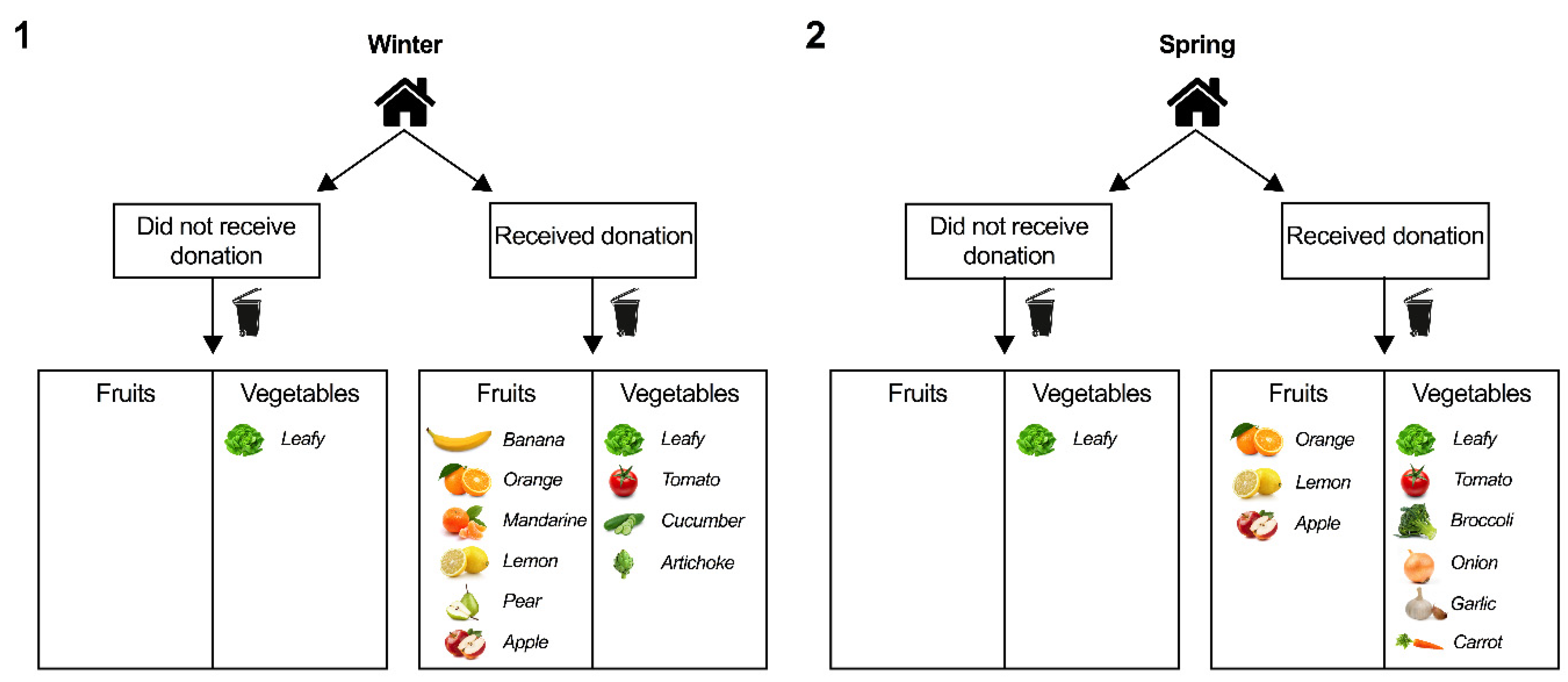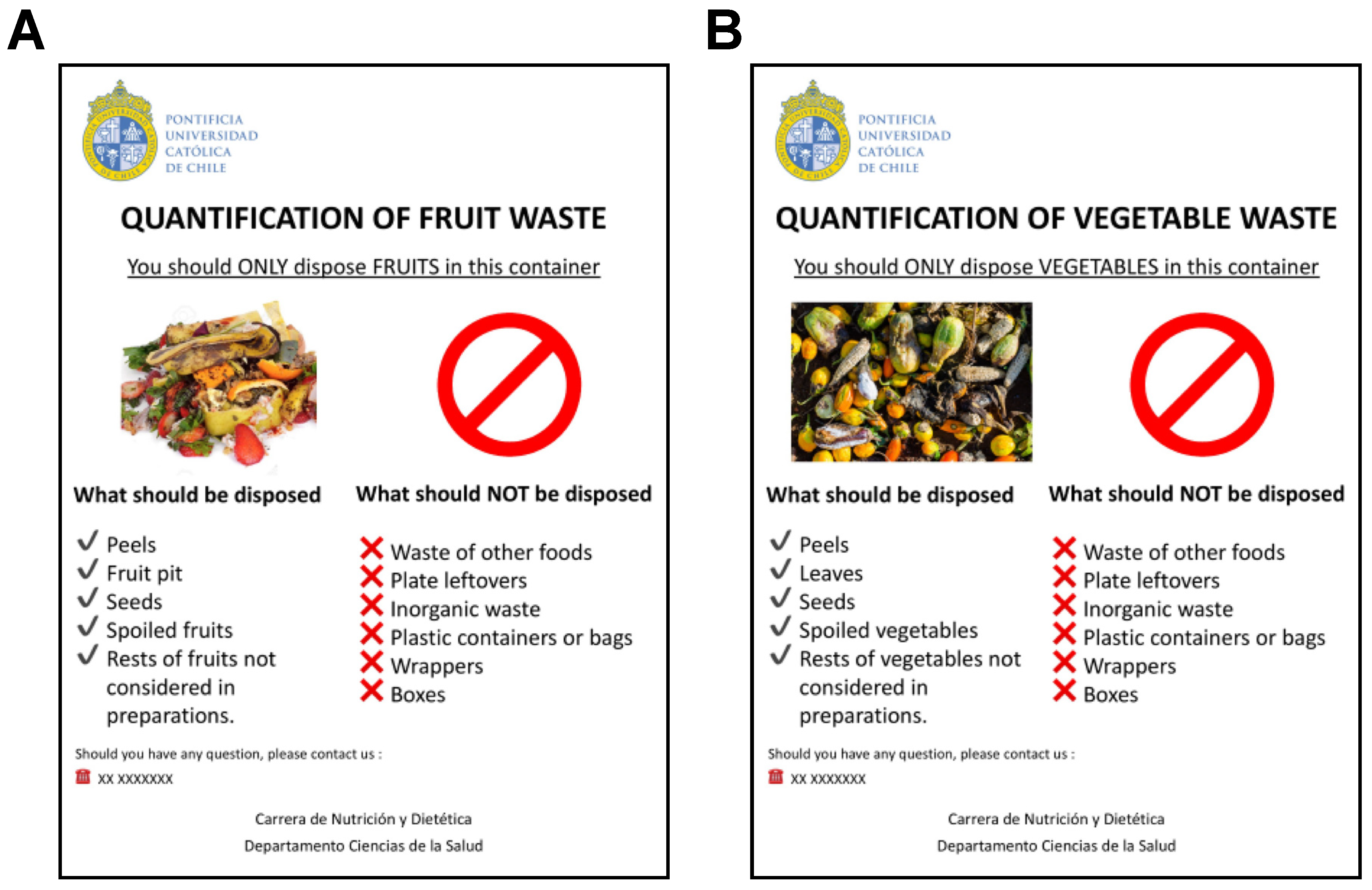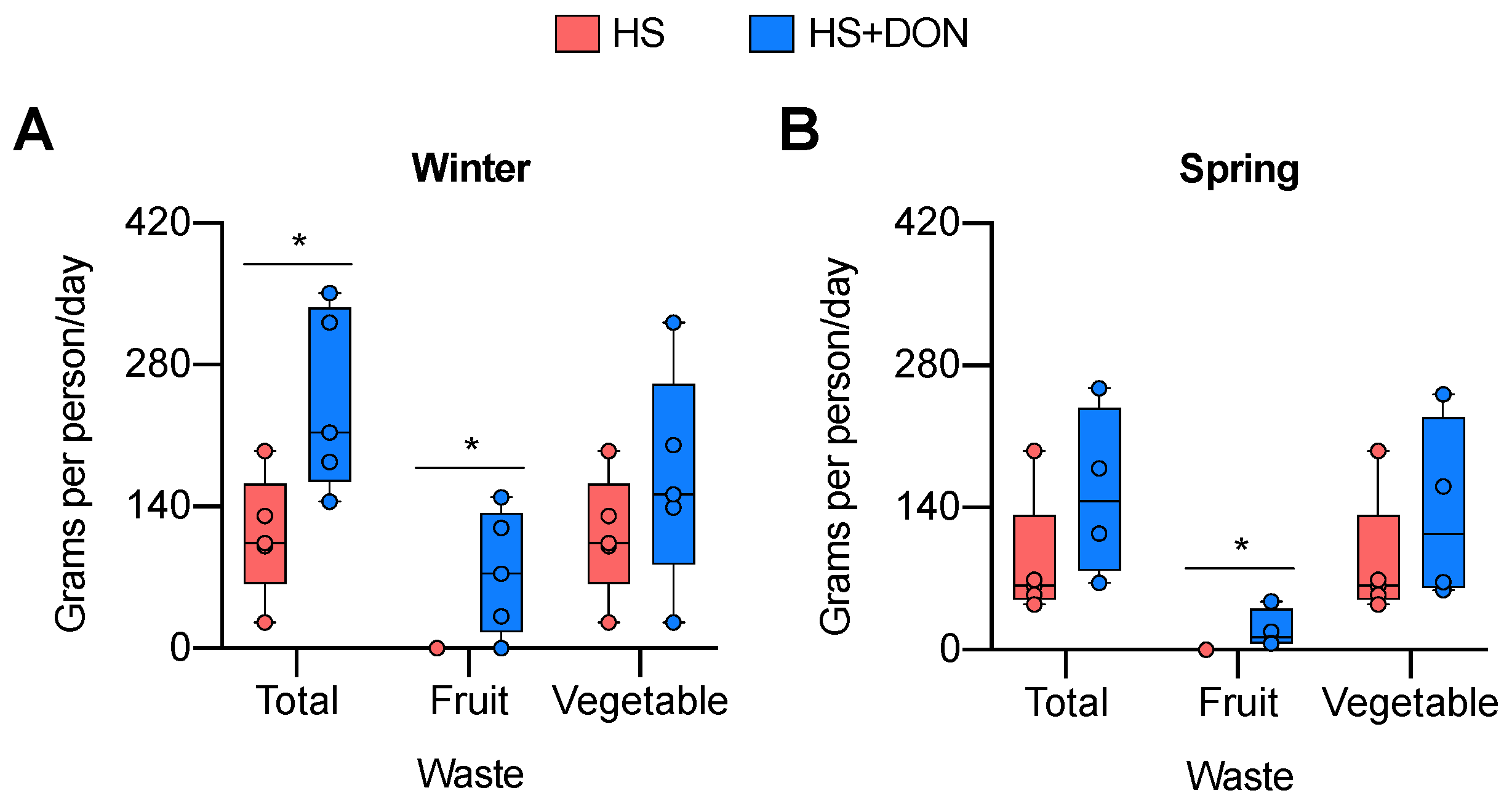Exploring Fruit and Vegetable Waste in Homeless Shelters that Receive Surplus Donation from a Wholesale Market in Chile
Abstract
1. Introduction
- Do homeless shelters that receive donation of fruit and vegetable surplus produce a similar amount of waste than homeless shelters that did not receive such a donation?
- Are the reasons that explain waste similar between homeless shelters that receive a donation of fruit and vegetable surplus and homeless shelters that did not receive such a donation?
2. Literature Review
2.1. Fruit and Vegetable Surplus and Waste
2.2. Methodologies to Quantify Fruit and Vegetable Waste in Households
2.3. Reasons to Explain Fruit and Vegetable Waste in Households
3. Materials and Methods
3.1. Design
3.2. Fruit and Vegetable Surplus
3.3. Homeless Shelters
3.4. Direct Quantification of Fruit and Vegetable Waste
3.5. Financial Value and Nutritional Content of Waste
3.6. Reasons to Explain Fruit and Vegetable Waste
3.7. Analyses
4. Results
4.1. Fruit and Vegetable Waste at Homeless Shelters
4.1.1. Winter
4.1.2. Spring
4.2. Financial Value and Nutritional Content of Waste
4.2.1. Winter
4.2.2. Spring
4.3. Reasons to Explain Waste
4.3.1. Winter
4.3.2. Spring
5. Discussion
5.1. Production of Fruit and Vegetable Waste
5.2. Economical Cost and Nutritional Content of Waste
5.3. Reasons that Explain Waste
5.4. A Tailored Donation Plan for Fruit and Vegetable Surplus: A Practical Contribution
6. Limitations
7. Conclusions and Future Perspectives
Author Contributions
Funding
Acknowledgments
Conflicts of Interest
Appendix A

References
- Gustavsson, J.; Cederberg, C.; Sonesson, U.; Otterdijk, V.; Meybeck, A. Global Food Losses and Food Waste; Food and Agriculture Organization of the United Nations (FAO): Rome, Italy, 2011. [Google Scholar]
- FAO. The State of Food and Agriculture 2019. Moving Forward on Food Loss and Waste Reduction; Food and Agriculture Organization of the United Nations (FAO): Rome, Italy, 2019. [Google Scholar]
- Adhikari, B.K.; Barrington, S.; Martinez, J. Predicted Growth of World Urban Food Waste and Methane Production. Waste Manag. Res. 2006, 24, 421–433. [Google Scholar] [CrossRef] [PubMed]
- FAO; IFAD; UNICEF; WFP; WHO. The State of Food Security and Nutrition in the World 2019. Safeguarding against Economic Slowdowns and Downturns; Food and Agriculture Organization of the United Nations (FAO): Rome, Italy, 2019. [Google Scholar]
- Papargyropoulou, E.; Lozano, R.; Steinberger, J.K.; Wright, N.; Bin Ujang, Z. The Food Waste Hierarchy as a Framework for the Management of Food Surplus and Food Waste. J. Clean. Prod. 2014, 76, 106–115. [Google Scholar] [CrossRef]
- Adamashvili, N.; Chiara, F.; Fiore, M. Food Loss and Waste, a Global Responsibility?! Econ. Agro-Aliment. 2020, 21, 825–846. [Google Scholar] [CrossRef]
- Roe, B.E.; Qi, D.; Bender, K.E. Some Issues in the Ethics of Food Waste. Physiol. Behav. 2020, 219, 112860. [Google Scholar] [CrossRef]
- Smil, V. Improving Efficiency and Reducing Waste in Our Food System. Environ. Sci. 2004, 1, 17–26. [Google Scholar] [CrossRef]
- Hodges, R.J.; Buzby, J.C.; Bennett, B. Postharvest Losses and Waste in Developed and Less Developed Countries: Opportunities to Improve Resource Use. J. Agric. Sci. 2011, 149, 37–45. [Google Scholar] [CrossRef]
- Garrone, P.; Melacini, M.; Perego, A.; Sert, S. Reducing Food Waste in Food Manufacturing Companies. J. Clean. Prod. 2016, 137, 1076–1085. [Google Scholar] [CrossRef]
- Teigiserova, D.A.; Hamelin, L.; Thomsen, M. Towards Transparent Valorization of Food Surplus, Waste and Loss: Clarifying Definitions, Food Waste Hierarchy, and Role in the Circular Economy. Sci. Total Environ. 2020, 706, 136033. [Google Scholar] [CrossRef]
- Nosratabadi, S.; Mosavi, A.; Shamshirband, S.; Kazimieras Zavadskas, E.; Rakotonirainy, A.; Chau, K.W. Sustainable Business Models: A Review. Sustainability 2019, 11, 1663. [Google Scholar] [CrossRef]
- Rauter, R.; Jonker, J.; Baumgartner, R.J. Going One’s Own Way: Drivers in Developing Business Models for Sustainability. J. Clean. Prod. 2017, 140, 144–154. [Google Scholar] [CrossRef]
- Pellegrini, G.; Annosi, M.C.; Contò, F.; Fiore, M. What Are the Conflicting Tensions in an Italian Cooperative and How Do Members Manage Them? Business Goals’, Integrated Management, and Reduction of Waste within a Fruit and Vegetables Supply Chain. Sustainability 2020, 12, 3050. [Google Scholar] [CrossRef]
- Storup, K.; Mattfolk, K.; Voinea, D.; Jakobsen, B.; Bain, M.; Reverté Casas, M.; Oliveira, P. Combating Food Waste: An Opportunity for the EU to Improve the Resource-Efficiency of the Food Supply Chain; European Court of Auditors, European Union: Luxembourg, 2016. [Google Scholar] [CrossRef]
- United States Environmental Protection Agency. Food Recovery Hierarchy. Available online: https://www.epa.gov/sustainable-management-food/food-recovery-hierarchy (accessed on 6 January 2020).
- CEC. Technical Report: Quantifying Food Loss and Waste and Its Impacts; Commission for Environmental Cooperation: Montreal, QC, Canada, 2019. [Google Scholar]
- Garrone, P.; Melacini, M.; Perego, A. Opening the Black Box of Food Waste Reduction. Food Policy 2014, 46, 129–139. [Google Scholar] [CrossRef]
- Chen, C.R.; Chen, R.J. Using Two Government Food Waste Recognition Programs to Understand Current Reducing Food Loss and Waste Activities in the U.S. Sustainability 2018, 10, 2760. [Google Scholar] [CrossRef]
- Otten, J.; Getts, K.; Diedrich, S.; Benson, C. Commercial and Anti-Hunger Sector Views on Local Government Strategies for Helping to Manage Food Waste. J. Agric. Food Syst. Community Dev. 2018, 8, 55–72. [Google Scholar] [CrossRef]
- Eguillor, P.; Acuña, D. Pérdida y Desperdicio de Alimentos En El Sector Agrícola: Avances y Desafíos; Oficina de Estudios y Políticas Agrarias—Odepa, Ministerio de Agricultura: Santiago, Chile, 2019.
- De Laurentiis, V.; Corrado, S.; Sala, S. Quantifying Household Waste of Fresh Fruit and Vegetables in the EU. Waste Manag. 2018, 77, 238–251. [Google Scholar] [CrossRef] [PubMed]
- Philip, D.; Hod-Ovadia, S.; Troen, A.M. A Technical and Policy Case Study of Large-Scale Rescue and Redistribution of Perishable Foods by the “Leket Israel” Food Bank. Food Nutr. Bull. 2017, 38, 226–239. [Google Scholar] [CrossRef] [PubMed]
- Efrati Philip, D.; Baransi, G.; Shahar, D.R.; Troen, A.M. Food-Aid Quality Correlates Positively With Diet Quality of Food Pantry Users in the Leket Israel Food Bank Collaborative. Front. Nutr. 2018, 5, 1–13. [Google Scholar] [CrossRef] [PubMed]
- USDA. FoodData Central. Available online: https://fdc.nal.usda.gov/ (accessed on 9 January 2020).
- Taiz, L.; Zeiger, E. Plant Physiology; The Benjamin/Cummings Publishing Company, Inc: San Francisco, CA, USA, 1991. [Google Scholar]
- Ventour, L. The Food We Waste; Waste & Resources Action Programme: Banbury, UK, 2008; Volume 2. [Google Scholar]
- Elimelech, E.; Ayalon, O.; Ert, E. What Gets Measured Gets Managed: A New Method of Measuring Household Food Waste. Waste Manag. 2018, 76, 68–81. [Google Scholar] [CrossRef] [PubMed]
- Blanke, M. Challenges of Reducing Fresh Produce Waste in Europe—From Farm to Fork. Agriculture 2015, 5, 389–399. [Google Scholar] [CrossRef]
- Zan, F.; Dai, J.; Hong, Y.; Wong, M.; Jiang, F.; Chen, G. The Characteristics of Household Food Waste in Hong Kong and Their Implications for Sewage Quality and Energy Recovery. Waste Manag. 2018, 74, 63–73. [Google Scholar] [CrossRef]
- Van Dooren, C.; Janmaat, O.; Snoek, J.; Schrijnen, M. Measuring Food Waste in Dutch Households: A Synthesis of Three Studies. Waste Manag. 2019, 94, 153–164. [Google Scholar] [CrossRef] [PubMed]
- Garcia-Herrero, I.; Hoehn, D.; Margallo, M.; Laso, J.; Bala, A.; Batlle-Bayer, L.; Fullana, P.; Vazquez-Rowe, I.; Gonzalez, M.J.; Durá, M.J.; et al. On the Estimation of Potential Food Waste Reduction to Support Sustainable Production and Consumption Policies. Food Policy 2018, 80, 24–38. [Google Scholar] [CrossRef]
- Manios, Y.; Harizani, K.; Markakis, G.; Galani, P.; Manios, T. Relating Fruit and Vegetable Consumption in Households with Residue Generation and Utilization in the City of Heraklion, Crete, Greece. Int. J. Sustain. Dev. World Ecol. 2005, 12, 353–360. [Google Scholar] [CrossRef]
- Khalid, S.; Naseer, A.; Shahid, M.; Shah, G.M.; Ullah, M.I.; Waqar, A.; Abbas, T.; Imran, M.; Rehman, F. Assessment of Nutritional Loss with Food Waste and Factors Governing This Waste at Household Level in Pakistan. J. Clean. Prod. 2019, 206, 1015–1024. [Google Scholar] [CrossRef]
- Jörissen, J.; Priefer, C.; Bräutigam, K.R. Food Waste Generation at Household Level: Results of a Survey among Employees of Two European Research Centers in Italy and Germany. Sustainability 2015, 7, 2695–2715. [Google Scholar] [CrossRef]
- Simunek, J.; Derflerova-Brazdova, Z.; Vitu, K. Food Wasting: A Study among Central European Four-Member Families. Int. Food Res. J. 2015, 22, 2679–2683. [Google Scholar]
- Elimelech, E.; Ert, E.; Ayalon, O. Bridging the Gap between Self-Assessments and Measured Household Food Waste: A Hybrid Valuation Approach. Waste Manag. 2019, 95, 259–270. [Google Scholar] [CrossRef]
- Hoj, S.B. Metrics and Measurement Methods for the Monitoring and Evaluation of Household Food Waste Prevention Interventions. Master’s Thesis, University of South Australia, Adelaide, Australia, 2011. [Google Scholar]
- Claudia, G.; Simone, P.; Matteo, B.; Luca, F. Are Questionnaires a Reliable Method to Measure Food Waste? A Pilot Study on Italian Households. Br. Food J. 2018, 120, 2885–2897. [Google Scholar] [CrossRef]
- Delley, M.; Brunner, T.A. Household Food Waste Quantification: Comparison of Two Methods. Br. Food J. 2018, 120, 1504–1515. [Google Scholar] [CrossRef]
- Elimelech, E.; Ert, E.; Ayalon, O. Exploring the Drivers behind Self-Reported and Measured Food Wastage. Sustainability 2019, 11, 5677. [Google Scholar] [CrossRef]
- Aschemann-Witzel, J.; Giménez, A.; Ares, G. Household Food Waste in an Emerging Country and the Reasons Why: Consumer’s Own Accounts and How It Differs for Target Groups. Resour. Conserv. Recycl. 2019, 145, 332–338. [Google Scholar] [CrossRef]
- Prasilova, M.; Varvazovska, P.; Pachtova, A. Foodstuffs Wastage in Czech Households. In Proceedings of the Adved 2017: 3rd International Conference on Advances in Education and Social Science, Istanbul, Turkey, 9–11 October 2017; pp. 432–437. [Google Scholar]
- Cronje, N.; van der Merwe, I.; Muller, I.-M. Household Food Waste: A Case Study in Kimberly, South Africa. J. Consum. Sci. 2018, 46, 1–9. [Google Scholar]
- Gaiani, S.; Caldeira, S.; Adorno, V.; Segrè, A.; Vittuari, M. Food Wasters: Profiling Consumers’ Attitude to Waste Food in Italy. Waste Manag. 2018, 72, 17–24. [Google Scholar] [CrossRef] [PubMed]
- Stangherlin, I.d.C.; Ribeiro, J.L.D.; Barcellos, M. Consumer Behaviour towards Suboptimal Food Products: A Strategy for Food Waste Reduction. Br. Food J. 2019, 121, 2396–2412. [Google Scholar] [CrossRef]
- Ramukhwatho, F.R.; du Plessis, R.; Oelofse, S. Household Food Wastage in a Developing Country: A Case Study of Mamelodi Township in South Africa. In Proceedings of the 20th WasteCon Conference, Cape Town, South Africa, 6–10 October 2014; pp. 468–475. [Google Scholar]
- Baglioni, S.; De Pieri, B.; Tallarico, T. Surplus Food Recovery and Food Aid: The Pivotal Role of Non-Profit Organisations. Insights from Italy and Germany. Volunt. Int. J. Volunt. Nonprofit Organ. 2017, 28, 2032–2052. [Google Scholar] [CrossRef]
- ODEPA. Mayoristas Frutas y Verduras. Available online: https://www.odepa.gob.cl/precios/mayoristas-frutas-y-hortalizas (accessed on 16 January 2020).
- Miller, V.; Yusuf, S.; Chow, C.K.; Dehghan, M.; Corsi, D.J.; Lock, K.; Popkin, B.; Rangarajan, S.; Khatib, R.; Lear, S.A.; et al. Availability, Affordability, and Consumption of Fruits and Vegetables in 18 Countries across Income Levels: Findings from the Prospective Urban Rural Epidemiology (PURE) Study. Lancet Glob. Health 2016, 4, e695–e703. [Google Scholar] [CrossRef]
- Silvennoinen, K.; Nisonen, S.; Pietiläinen, O. Food Waste Case Study and Monitoring Developing in Finnish Food Services. Waste Manag. 2019, 97, 97–104. [Google Scholar] [CrossRef]
- WHO; FAO. Diet, Nutrition, and the Prevention of Chronic Diseases (Report of a Joint WHO and FAO Expert Consulation); WHO: Geneva, Switzerland, 2003; Volume 916. [Google Scholar]
- Edjabou, M.E.; Petersen, C.; Scheutz, C.; Astrup, T.F. Food Waste from Danish Households: Generation and Composition. Waste Manag. 2016, 52, 256–268. [Google Scholar] [CrossRef]
- Hanc, A.; Novak, P.; Dvorak, M.; Habart, J.; Svehla, P. Composition and Parameters of Household Bio-Waste in Four Seasons. Waste Manag. 2011, 31, 1450–1460. [Google Scholar] [CrossRef]
- Van Der Werf, P.; Seabrook, J.A.; Gilliland, J.A. The Quantity of Food Waste in the Garbage Stream of Southern Ontario, Canada Households. PLoS ONE 2018, 13, e0198470. [Google Scholar] [CrossRef]



| ID | Received Fruit and Vegetable Surplus Donation | Beneficiaries (n) | Meals (n per Beneficiary/day) | Distance from the Wholesale Market (km) |
|---|---|---|---|---|
| 1 | Yes | 43 | 4 | 45 |
| 2 | Yes | 100 | 4 | 35 |
| 3 | Yes | 45 | 4 | 36 |
| 4 | Yes | 30 | 4 | 37 |
| 5 | Yes | 120 | 4 | 12 |
| 6 | No | 89 | 4 | 13 |
| 7 | No | 100 | 4 | 10 |
| 8 | No | 126 | 4 | 14 |
| 9 | No | 54 | 4 | 10 |
| 10 | No | 120 | 4 | 14 |
| HS (n = 5) | HS+DON (n = 5) | |
|---|---|---|
| Winter | ||
| Financial value, USD | 0.08 (0.05–0.12) | 0.16 (0.13–0.25) * |
| Energy, kcal | 26 (16–40) | 75 (64–106) ** |
| Carbohydrate, g | 5.5 (3.3–8.6) | 17.8 (14.8–24.8) ** |
| Dietary fiber, g | 2.1 (1.3–3.2) | 4.3 (3.4–6.8) * |
| Vitamin C, mg | 25 (15–38) | 58 (46–87) * |
| Potassium, mg | 261 (159–409) | 479 (356–789) # |
| Spring $ | ||
| Financial value, USD | 0.03 (0.02–0.06) | 0.08 (0.04–0.12) |
| Energy, kcal | 16 (12–33) | 46 (25–61) # |
| Carbohydrate, g | 3.3 (2.6–7.0) | 10.7 (5.7–13.4) # |
| Dietary fiber, g | 1.2 (1.0–2.6) | 3.0 (1.6–4.7) |
| Vitamin C, mg | 15 (12–31) | 38 (20–57) |
| Potassium, mg | 158 (125–333) | 344 (183–592) |
| Excess of Purchase or Donation | Not Received According to Meal Planning | Few Ways to Prepare Meals | Smell Moldy | Looked Badly | Too Perishable | |
|---|---|---|---|---|---|---|
| Fruit waste | ||||||
| Citrus | ||||||
| HS+DON (%) | 60–25% | 60–25% | 0–0% | 80–0% | 80–50% | 40–25% |
| Pomace | ||||||
| HS+DON (%) | 80–50% | 20–25% | 20–0% | 60–50% | 60–100% | 60–0% |
| Banana | ||||||
| HS+DON (%) | 60–25% | 20–25% | 0–0% | 40–0% | 100–25% | 100–25% |
| Vegetable waste | ||||||
| Leafy | ||||||
| HS (%) | 20–0% | 0–0% | 0–0% | 20–20% | 100–40% | 0–20% |
| HS+DON (%) | 40–25% | 20–25% | 20–0% | 40–50% | 80–100% # | 80 *–75% # |
| Fruits | ||||||
| HS (%) | 20–0% | 0–0% | 0–0% | 80–0% | 20–40% | 0–20% |
| HS+DON (%) | 100 *–25% | 20–25% | 0–0% | 40–0% | 80 #–50% | 60 *–75% # |
| Stems | ||||||
| HS (%) | 0–0% | 0–0% | 40–0% | 0–0% | 80–40% | 20–20% |
| HS+DON (%) | 20–0% | 20–25% | 40–0% | 0–0% | 20 #–75% | 0–0% |
| Inflorescences | ||||||
| HS (%) | 20–0% | 0–0% | 0–0% | 20–40% | 60–40% | 0–40% |
| HS+DON (%) | 0–0% | 0–25% | 20–0% | 0–0% | 0 *–75% | 0–0% |
| Bulbs | ||||||
| HS (%) | 20–0% | 0–0% | 0–0% | 100–40% | 80–20% | 0–0% |
| HS+DON (%) | 40–50%# | 0–25% | 0–0% | 20 *–75% | 20 #–100% * | 20–0% |
| Root and tubers | ||||||
| HS (%) | 0–0% | 0–0% | 0–0% | 40–20% | 60–20% | 0–0% |
| HS+DON (%) | 20–25% | 0–25% | 0–0% | 20–25% | 20–100% * | 20–0% |
Publisher’s Note: MDPI stays neutral with regard to jurisdictional claims in published maps and institutional affiliations. |
© 2020 by the authors. Licensee MDPI, Basel, Switzerland. This article is an open access article distributed under the terms and conditions of the Creative Commons Attribution (CC BY) license (http://creativecommons.org/licenses/by/4.0/).
Share and Cite
Fredes, C.; García, F.; Pérez, M.I.; Fernández-Verdejo, R. Exploring Fruit and Vegetable Waste in Homeless Shelters that Receive Surplus Donation from a Wholesale Market in Chile. Sustainability 2020, 12, 8835. https://doi.org/10.3390/su12218835
Fredes C, García F, Pérez MI, Fernández-Verdejo R. Exploring Fruit and Vegetable Waste in Homeless Shelters that Receive Surplus Donation from a Wholesale Market in Chile. Sustainability. 2020; 12(21):8835. https://doi.org/10.3390/su12218835
Chicago/Turabian StyleFredes, Carolina, Francisco García, María Ignacia Pérez, and Rodrigo Fernández-Verdejo. 2020. "Exploring Fruit and Vegetable Waste in Homeless Shelters that Receive Surplus Donation from a Wholesale Market in Chile" Sustainability 12, no. 21: 8835. https://doi.org/10.3390/su12218835
APA StyleFredes, C., García, F., Pérez, M. I., & Fernández-Verdejo, R. (2020). Exploring Fruit and Vegetable Waste in Homeless Shelters that Receive Surplus Donation from a Wholesale Market in Chile. Sustainability, 12(21), 8835. https://doi.org/10.3390/su12218835





